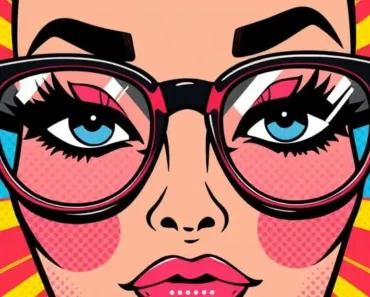Have you ever watched a cat’s graceful movements and thought “I wish I could capture that on paper”—but felt intimidated by where to even begin?
Cats are masters of form. From their fluid movements to their poised stillness, they are a perfect subject for any artist. If you have ever wanted to draw a cat but felt unsure where to begin, you are in the right place.
This guide removes the mystery and shows you that anyone can learn to sketch a convincing feline friend. We will start with simple shapes that build a solid foundation, then move on to adding the details that give your cat character. Forget complex anatomy lessons; we will focus on practical steps you can use right away.
Before You Start: Gathering Your Drawing Tools
Great art does not require expensive supplies, but the right tools make the process smoother. Before you draw a cat, gather a few basic items. Having these ready will help you focus on the creative process of capturing the feline form.
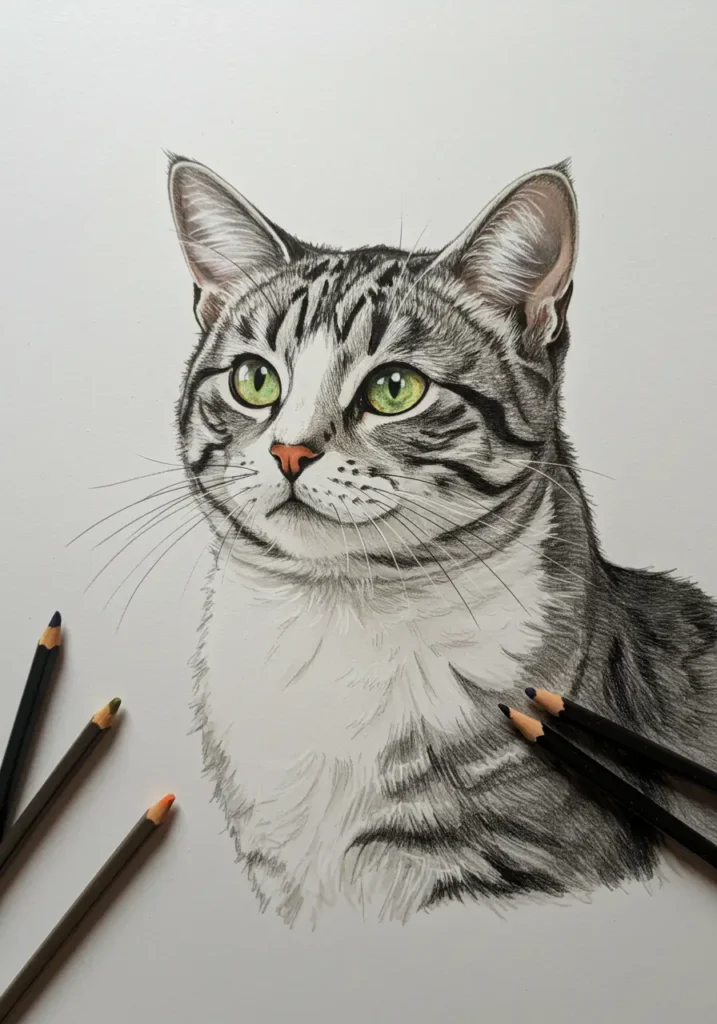
Essential Pencils
Different pencils create different effects. A small selection gives you control over your lines, from light initial sketches to dark, final details.
| Pencil Grade | Primary Use |
|---|---|
| HB or #2 | Perfect for the initial sketch. It’s easy to erase and not too dark. |
| 2B | A slightly softer pencil, good for refining lines and light shading. |
| 4B or 6B | These soft pencils are excellent for dark shadows and creating rich texture in the fur. |
Paper and Erasers
You need a surface for your creation. For pencil drawing, a smooth-surfaced paper like sketch or drawing paper works best. Avoid standard copy paper, which can be too thin. For erasers, a kneaded eraser is ideal. You can mold it to a fine point to lift small mistakes without smudging. A standard white vinyl eraser is good for larger areas.
Quick reflection: Do you already have drawing supplies at home, or will you need to gather a few basics before starting your cat sketch?
The Foundation: Drawing a Simple Cat with Basic Shapes
The secret to learning how to draw a cat is to see the basic shapes within a complex form. We will build our cat from simple circles and ovals. This method ensures your proportions are correct from the very start. Use your HB pencil for these steps so you can erase the guidelines later.
Step 1: The Head and Body Circles
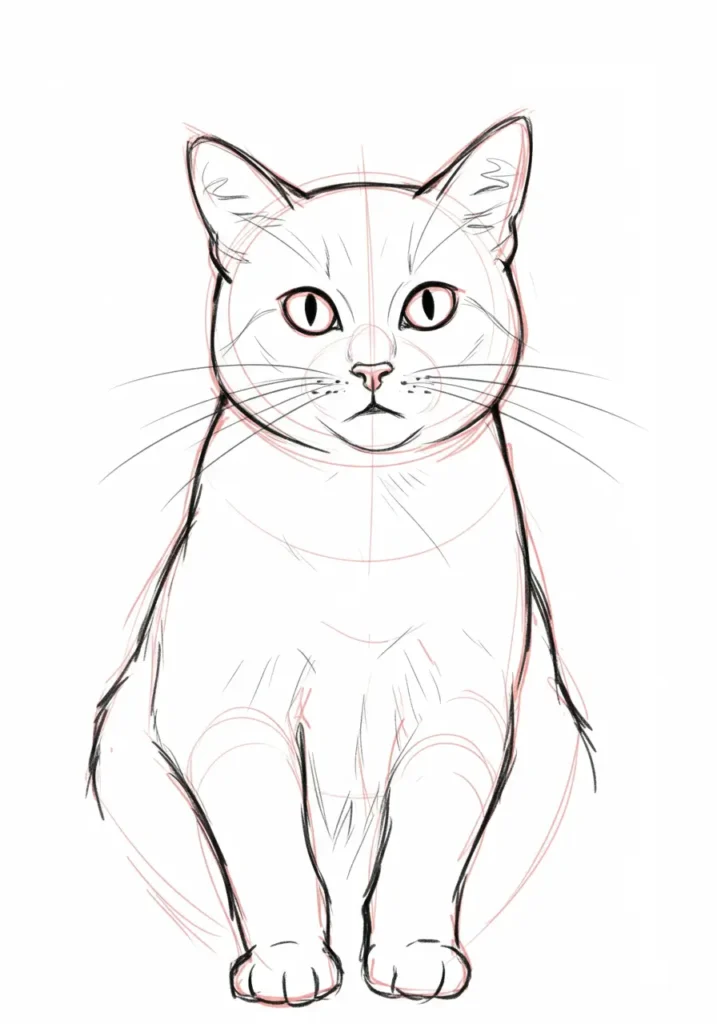
Start by drawing a circle for the cat’s head. Below and slightly overlapping it, draw a larger, slightly elongated oval for the body. The overlap is important; it will become the cat’s powerful shoulders.
Step 2: Connecting the Shapes
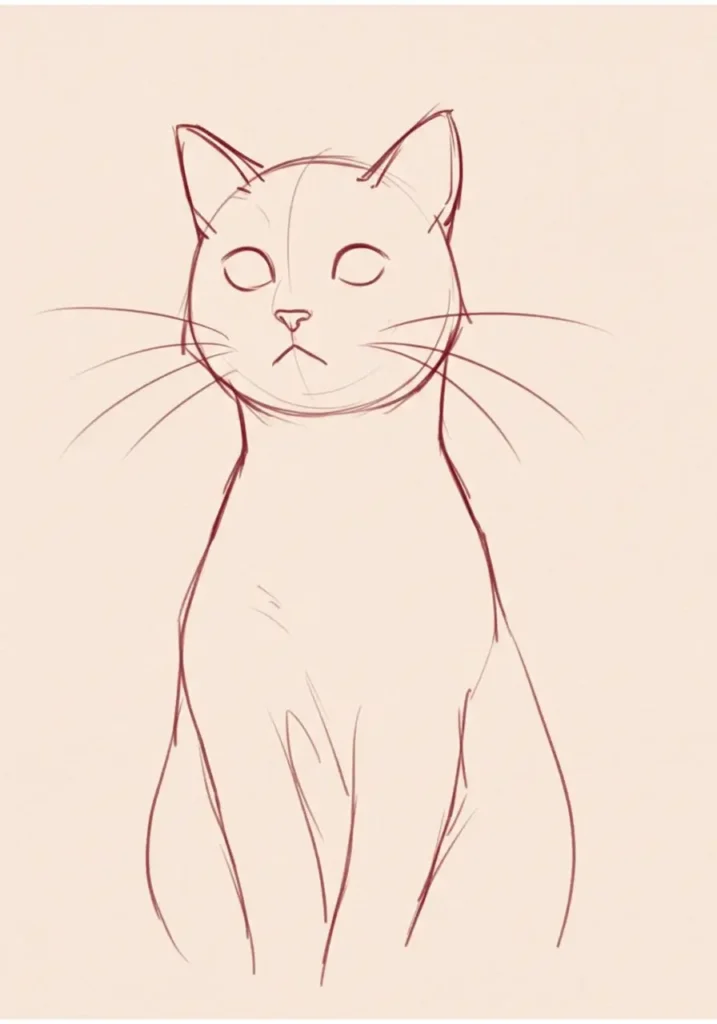
Draw two soft, curved lines to connect the head circle to the body oval. This creates the neck. Imagine a gentle, flowing line that runs from the top of the head down the back of the body oval—this is the cat’s spine and will help guide the tail’s position.
Step 3: Adding the Legs and Tail
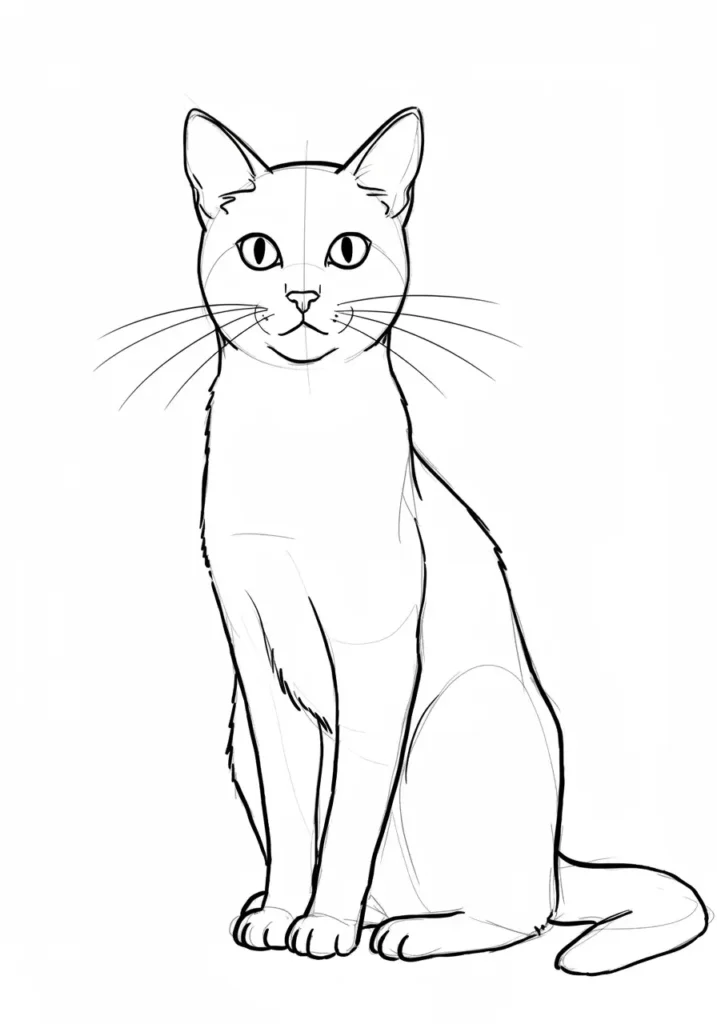
For the front legs, draw two long oval shapes extending from the bottom of the body. For the hind legs, which are often bent when a cat is sitting, draw larger, more rounded ovals. Don’t worry about paws yet. For the tail, draw a long, curving line extending from the end of the spine.
Step 4: Sketching the Face Guidelines
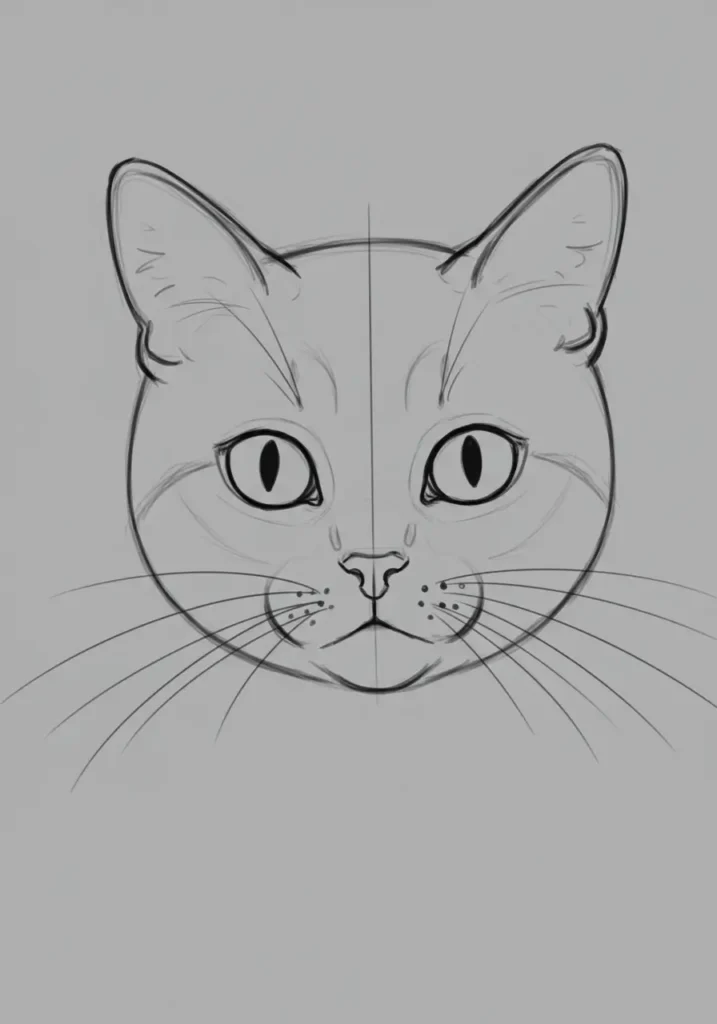
Return to the head circle. Draw a vertical line down the middle and a horizontal line across the middle. The horizontal line is where the eyes will sit. The vertical line helps you place the nose and mouth symmetrically. Finally, add two rounded triangles on top of the head for ears.
Related Posts: How to Draw a Flower: Complete Step-by-Step Guide
Bringing Your Cat to Life: Adding Details
With your basic structure in place, it’s time for the fun part. This is where you truly begin to draw a cat by adding the details that transform your shapes into a recognizable feline.
How to Draw a Cat Face
When you draw a cat, the face holds all the expression. Take your time here.
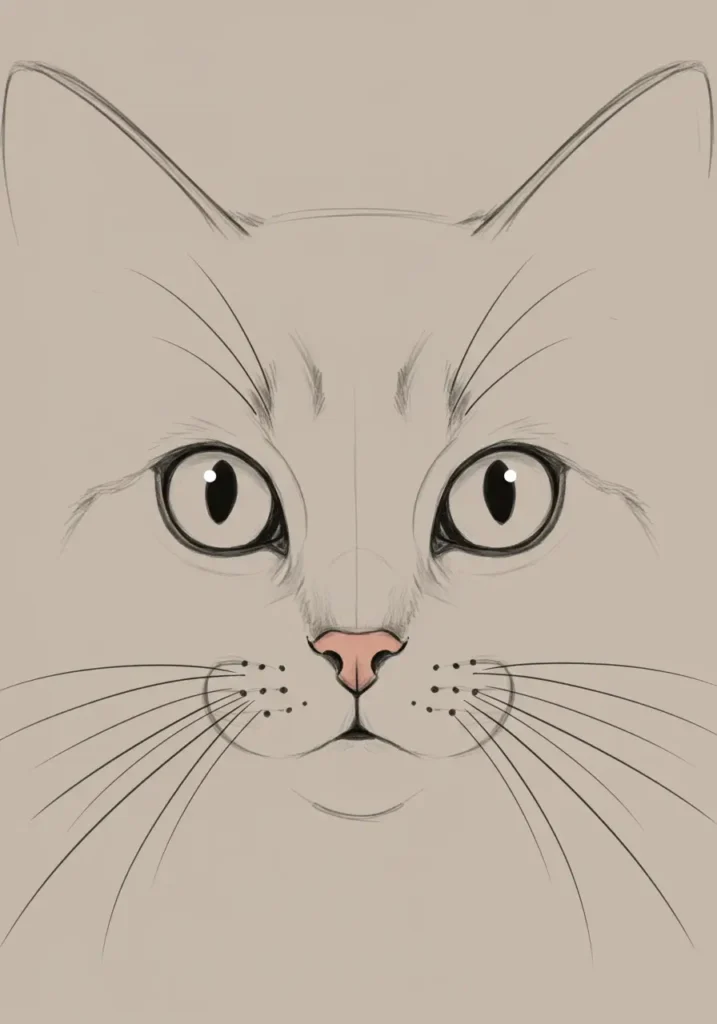
The Eyes
On the horizontal guideline you drew, sketch two almond shapes for the eyes. A cat’s eyes are one of its most captivating features. Inside each eye, draw a circle for the iris and a vertical slit for the pupil. Leave a tiny white dot in the iris to represent a highlight; this small detail makes the eyes look wet and alive.
The Nose and Mouth
At the intersection of your guidelines, draw a small, upside-down triangle for the nose. From the bottom point of the triangle, draw a straight line down. From the bottom of that line, draw two curved lines, like a soft “W,” to form the mouth.
Whiskers and Ears
Add a few dots on either side of the nose and draw long, thin, slightly curved lines outward for the whiskers. Refine the triangle ears by adding a smaller shape inside to suggest depth.
Refining the Body and Paws
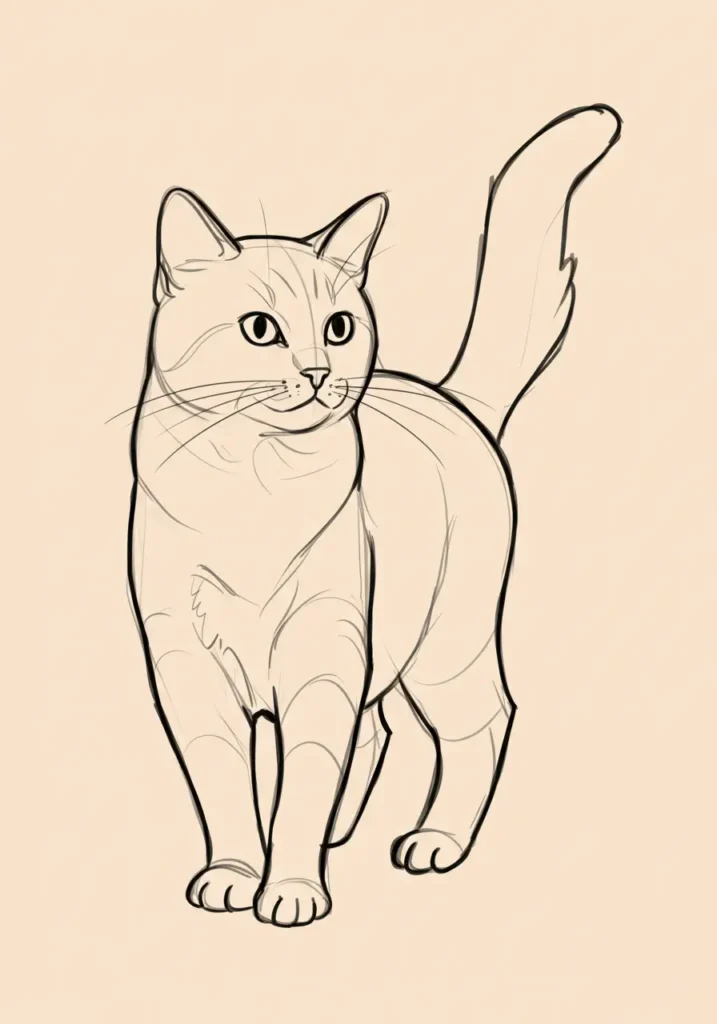
Go over your initial shape guidelines, turning the simple ovals into more defined legs. Add small semi-circles at the bottom of the leg ovals to create paws. Connect all your shapes with smooth, confident lines, erasing the initial, lighter guidelines as you go. Thicken the tail line to give it form.
The Art of Drawing Cat Fur
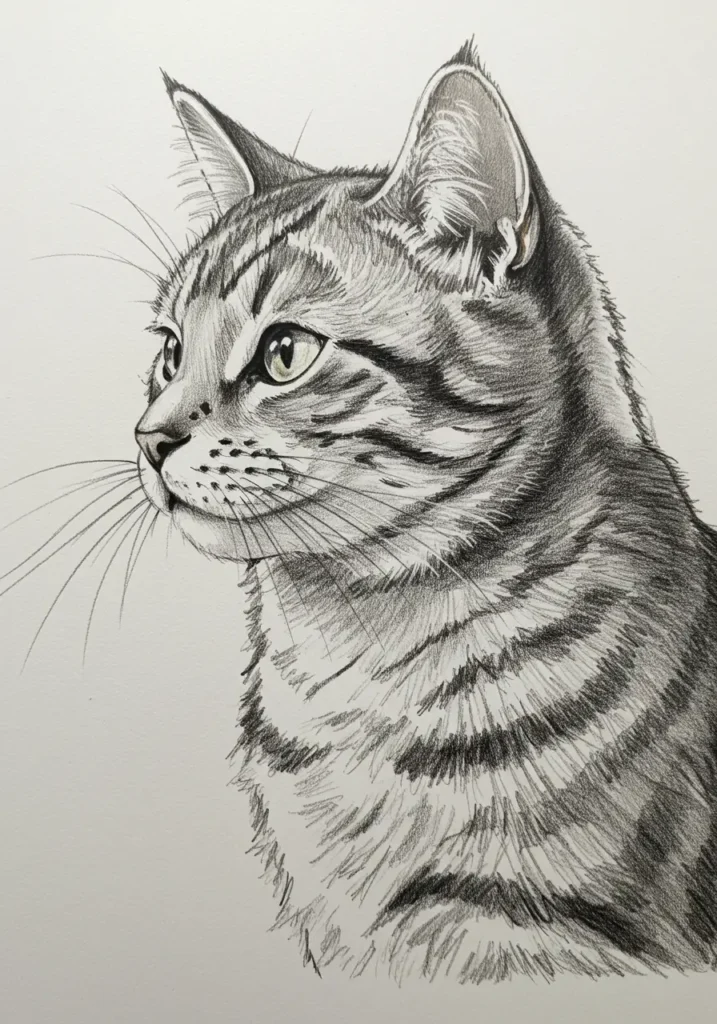
The key to drawing realistic fur when you draw a cat is to suggest texture rather than drawing every single hair. Use the side of your 4B pencil to add shading.
- Use short, quick strokes that follow the direction the fur would grow.
- Make the strokes longer for a long-haired cat and shorter for a short-haired cat.
- Add darker shading on the belly, under the neck, and on the side of the cat away from your imaginary light source. This creates a sense of three-dimensional form.
Quick reflection: Which detail—eyes, whiskers, or fur texture—are you most excited to practice first?
Exploring Different Styles: Cartoon vs. Realistic Cat Drawing
Once you master the basic form, you can adapt it to draw a cat in any style.
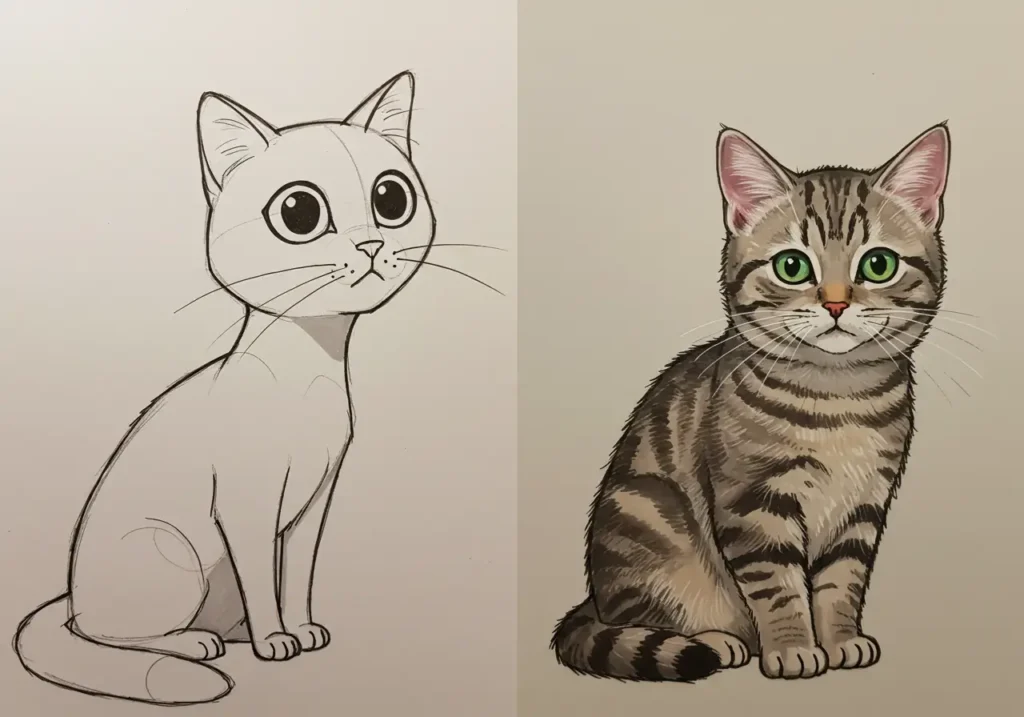
Creating a Cartoon Cat
To draw a cartoon cat, exaggerate its features. Make the eyes very large and round. Simplify the body into even more basic shapes. Give it a wide, expressive smile. Think about what makes a character cute or funny and amplify those traits. The lines are often cleaner and bolder than in a realistic drawing.
Tips for a More Realistic Cat
For realism, observation is your best friend. Look at photos of cats to understand their anatomy. Pay close attention to how muscles connect and how the fur lays on the body. Shading is critical for realism. Build up layers of tone slowly, from light to dark, to create depth and form. For great reference photos, you can visit a site like Pexels, which offers free, high-quality images.
Quick reflection: Are you drawn more to cartoon-style cats with exaggerated features, or do you prefer the challenge of realistic fur and anatomy?
Common Mistakes to Avoid When You Draw a Cat
Every artist makes mistakes. Here are a few common pitfalls and how to solve them when you draw a cat.
| Common Mistake | The Solution |
|---|---|
| The “Floating” Head The head looks disconnected from the body. |
Always draw a proper neck using two curved lines to connect the head and body shapes. |
| Stiff, Straight Tail The tail looks like a stick. |
Use a graceful “S” curve. A cat’s tail is very expressive and rarely perfectly straight. |
| Misplaced Eyes Eyes are too high on the head. |
Remember to use the horizontal guideline placed halfway down the head circle. This is a common rule in portraiture. |
| Drawing Every Hair The fur looks messy and unnatural. |
Focus on clumps of fur and use directional shading to create the illusion of texture. Less is more. |
Learning how to draw a cat is a skill that grows with practice. Your first drawing might not be perfect, and that is completely fine. The goal is to enjoy the process of creating something with your own hands. Each time you sketch, you will notice improvements in your lines, proportions, and details. Keep this guide handy, keep practicing, and soon you will be able to draw a cat you can be proud of with confidence and style.
What’s your cat drawing story—are you sketching your own feline friend, or practicing to surprise someone special with a custom portrait?
Share your progress and any tips you’ve discovered in the comments below—I’d love to see what you create!
Frequently Asked Questions
1. What’s the easiest cat pose to draw for a beginner?
The easiest pose is a cat sitting in profile or facing forward, as shown in this guide. This pose is stable and relies on simple, easy-to-draw shapes like circles and ovals without involving complex perspectives or foreshortening.
2. How can I make my cat drawing look 3D?
The key to a 3D look is shading. Determine a light source and add shadows on the parts of the cat opposite the light. Darken the areas underneath the chin, on the belly, and between the legs. This contrast between light and dark creates the illusion of volume and form.
3. What kind of paper is best for pencil drawings of cats?
A medium-weight, smooth-surfaced drawing paper (around 70-100 lb) is ideal. It is durable enough to handle erasing and multiple layers of pencil shading without tearing. Avoid overly textured (toothy) paper, as it can make smooth shading difficult.
4. How do I draw different cat breeds?
To draw different breeds, focus on their unique characteristics. A Siamese cat has a slender body and large ears. A Persian has a flatter face and long, thick fur. A Maine Coon is large with a shaggy coat and tufted ears. Start with the same basic shapes, but modify the proportions and fur texture based on photo references of the specific breed.
5. Can I draw a cat digitally using the same steps?
Absolutely. The fundamental principles of construction using basic shapes, guidelines, and layering details are the same for digital art. Use a light-colored brush on a separate layer for your initial sketch, then create a new layer on top to draw your final lines, just as you would use different pencils on paper.

